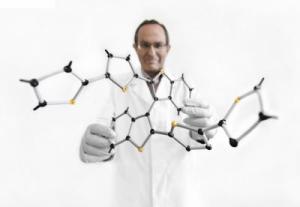Apr 21 2014
Electrically controlled glasses with continuously adjustable transparency, new polarisation filters, and even chemosensors capable of detecting single molecules of specific chemicals could be fabricated thanks to a new polymer unprecedentedly combining optical and electrical properties.
 Halves of a new polymer are connected at a single point and can be rotated with respect to each other by applying electric potential. Depending on the orientation of the halves, the new polymer either assumes or looses chirality. The polymer model is presented by Prof. W³odzimierz Kutner from the Institute of Physical Chemistry of the Polish Academy of Sciences in Warsaw.Credit: IPC PAS, Grzegorz Krzy¿ewski
Halves of a new polymer are connected at a single point and can be rotated with respect to each other by applying electric potential. Depending on the orientation of the halves, the new polymer either assumes or looses chirality. The polymer model is presented by Prof. W³odzimierz Kutner from the Institute of Physical Chemistry of the Polish Academy of Sciences in Warsaw.Credit: IPC PAS, Grzegorz Krzy¿ewski
An international team of chemists from Italy, Germany, and Poland developed a polymer with unique optical and electric properties. Components of this polymer change their spatial configuration depending on the electric potential applied. In turn, the polarisation of transmitted light is affected. The material can be used, for instance, in polarisation filters and window glasses with continuously adjustable transparency. Due to its mechanical properties, the polymer is also perfectly suitable for fabrication of chemical sensors for selective detection and determination of optically active (chiral) forms of an analyte.
The research findings of the international team headed by Prof. Francesco Sannicolo from the Universita degli Studi di Milano were recently published in one of the most prestigious chemical journals, Angewandte Chemie International Edition.
"Until now, to give polymers chiral properties, chiral pendants were attached to the polymer backbone. In such designs the polymer was used as a scaffold only. Our polymer is exceptional, with chirality inherent to it, and with no pending groups. The polymer is both a scaffold and an optically active chiral structure. Moreover, the polymer conducts electricity", comments Prof. Włodzimierz Kutner from the Institute of Physical Chemistry of the Polish Academy of Sciences (IPC PAS) in Warsaw, one of the initiators of the research.
Chirality can be best explained by referring to mirror reflection. If two varieties of the same object look like their mutual mirror images, they differ in chirality. Human hands provide perhaps the most universal example of chirality, and the difference between the left and right hand becomes obvious if we try to place a left-handed glove on a right hand. The same difference as between the left and right hand is between two chiral molecules with identical chemical composition. Each of them shows different optical properties, and differently rotates plane-polarised light. In such a case, chemists refer to one chemical compound existing as two optical isomers called enantiomers.
The polymer presented by Prof. Sannicolo's team was developed on the basis of thiophene, an organic compound composed of a five-member aromatic ring containing a sulphur atom. Thiophene polymerisation gives rise to a chemically stable polymer of high conductivity. The basic component of the new polymer – its monomer – is made of a dimer with two halves each made of two thiophene rings and one thianaphthene unit. The halves are connected at a single point and can partially be rotated with respect to each other by applying electric potential. Depending on the orientation of the halves, the new polymer either assumes or looses chirality. This behaviour is fully reversible and resembles a breathing system, whereas the "chiral breathing" is controlled by an external electric potential.
The development of a new polymer was initiated thanks to the research on molecular imprinting pursued at the Institute of Physical Chemistry of the PAS. The research resulted, for instance, in the development of polymers used as recognising units (receptors) in chemosensors, capable of selective capturing of molecules of various analytes, for instance nicotine, and also melamine, an ill-reputed chemical detrimental to human health, used as an additive to falsify protein content in milk and dairy products produced in China.
Generally, molecular imprinting consists in creating template-shaped cavities in polymer matrices with molecules of interest used first as cavity templates. Subsequently these templates are washed out from the polymer. As a result, the polymer contains traps with a shape and size matching those of molecules of the removed template. To be used as a receptor in chemosensor to recognize analyte molecules similar to templates or templates themselves, the polymer imprinted with these cavities must show a sufficient mechanical strength.
"Three-dimensional networks we attempted to build at the IPC PAS using existing two-dimensional thiophene derivatives just collapsed after the template molecules were removed. That's why we asked for assistance our Italian partners, specialising in the synthesis of thiophene derivatives. The problem was to design and synthesise a three-dimensional thiophene derivative that would allow us for cross-linking of our polymers in three dimensions. The thiophene derivative synthesised in Milan has a stable three-dimensional structure, and the controllable chiral properties of the new polymer obtained after the derivative was polymerised, turned out a nice surprise for all of us", explains Prof. Kutner.